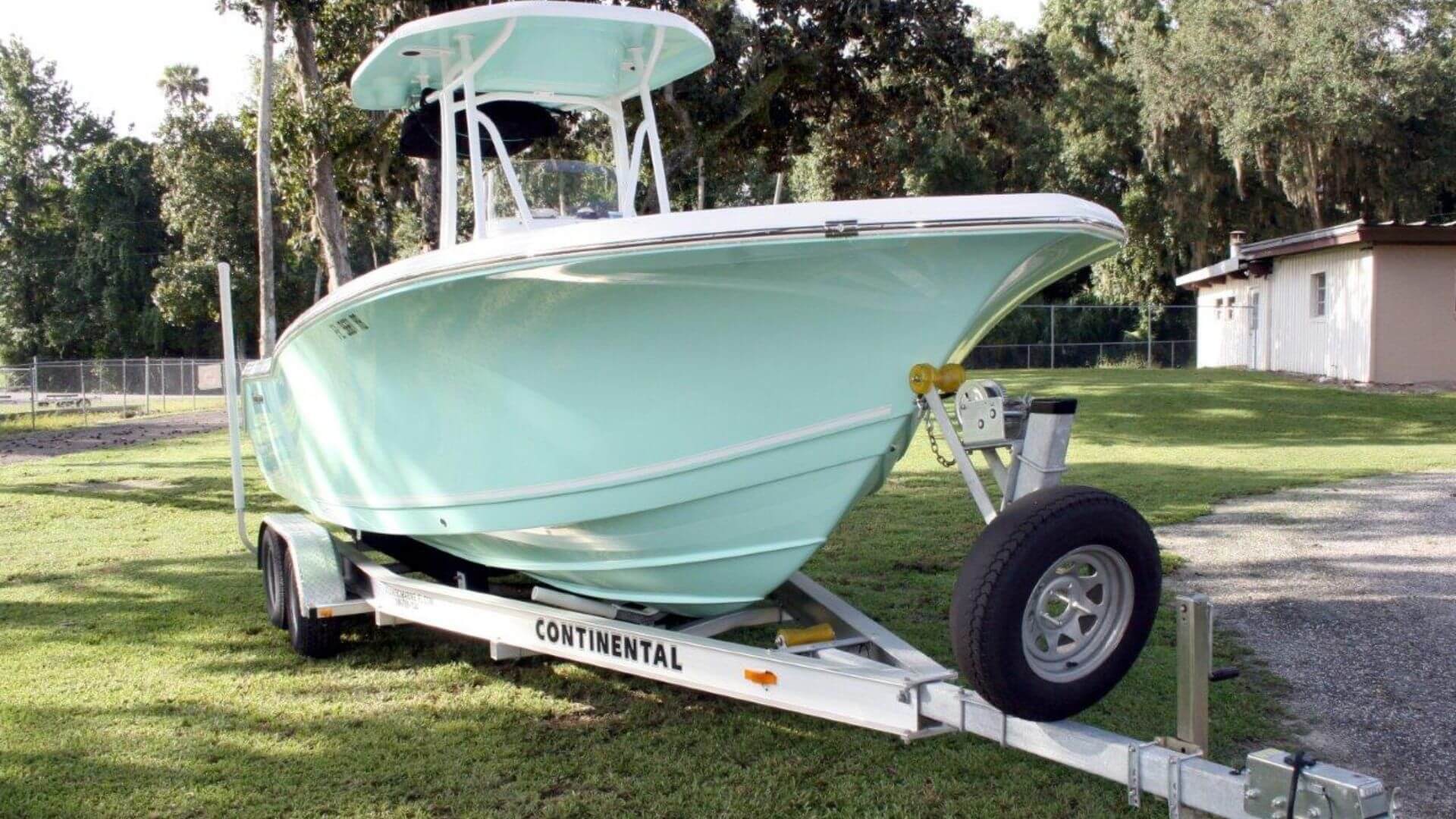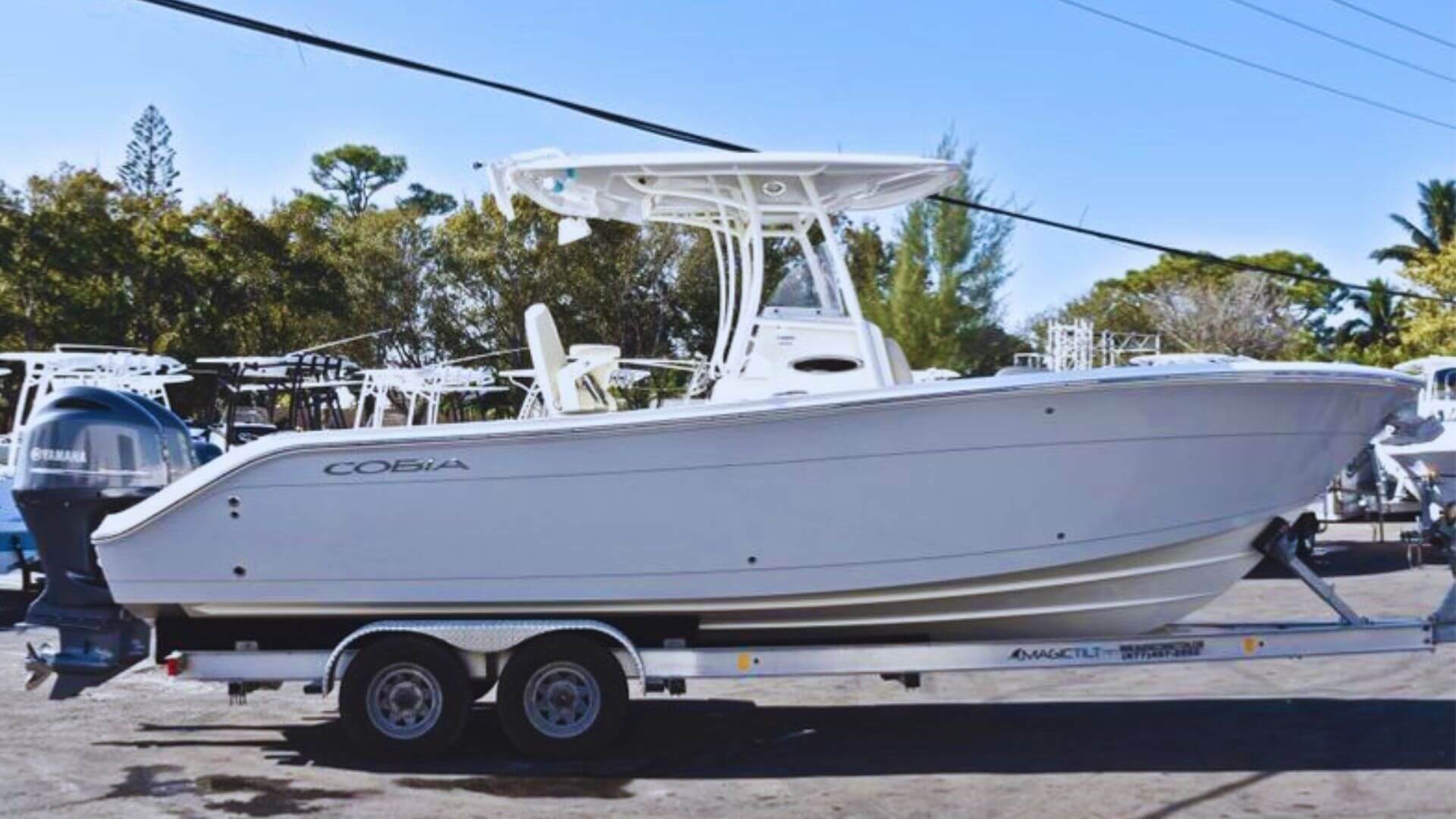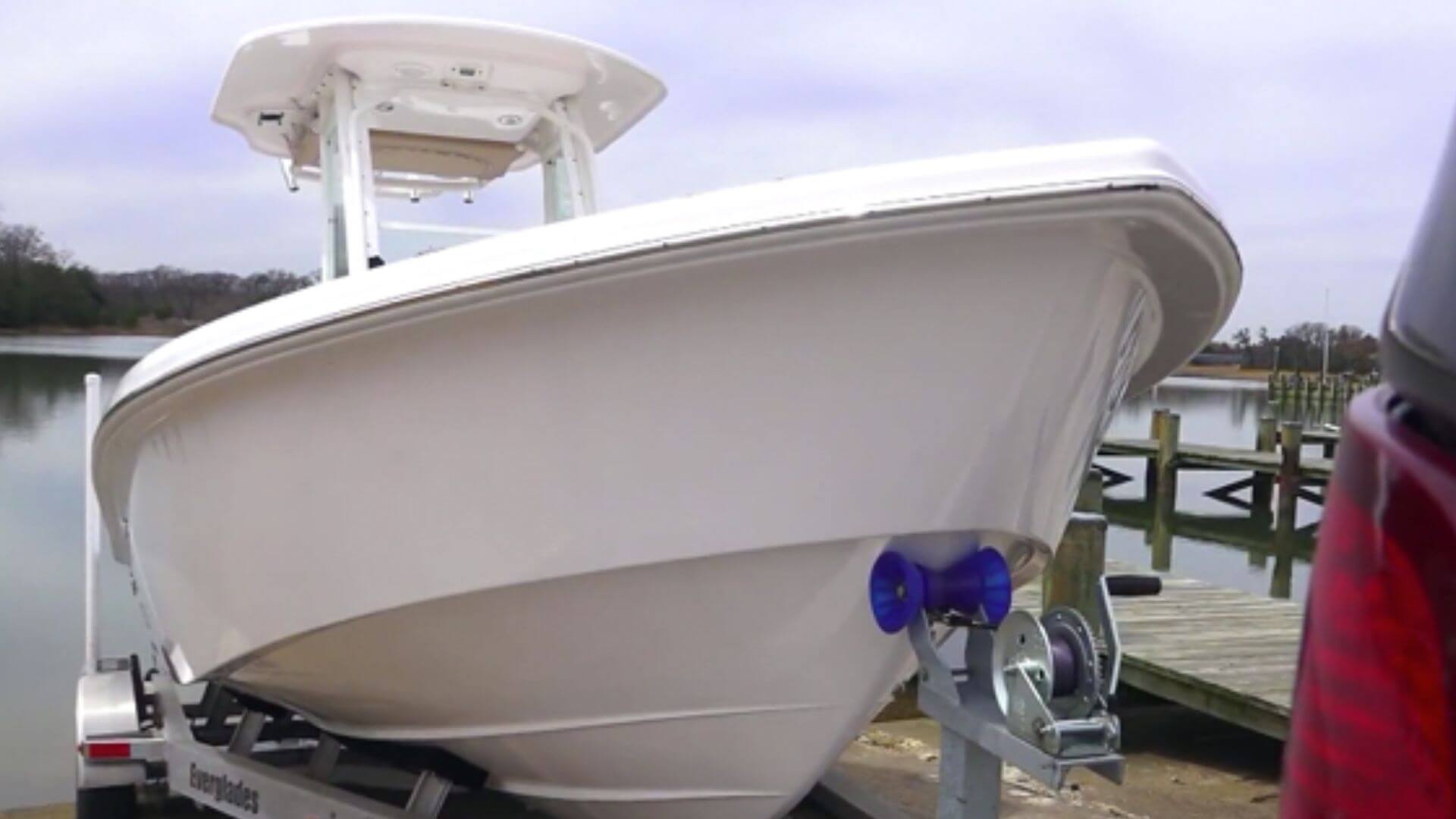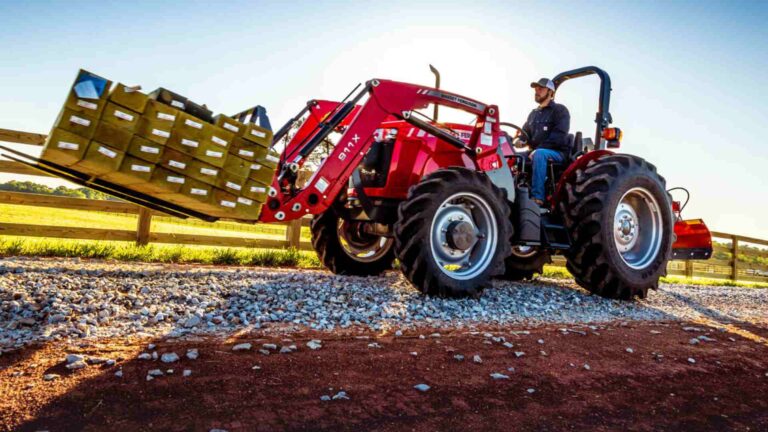How Should a Boat Sit on a Trailer Properly | Stepwise Guide
Introduction to the topic
Are you a boat owner or someone considering purchasing a boat? If so, you know that owning a boat comes with the excitement of exploring new waters and enjoying memorable adventures. However, one crucial aspect of boat ownership often gets overlooked: how the boat sit on a trailer.
In this article, we will delve into the important topic of how a boat should sit on a trailer. Properly positioning your boat on a trailer is not only essential for safe and efficient transportation but also for the overall longevity of your boat and trailer. Understanding the correct alignment, weight distribution, and securing techniques will give you peace of mind during road trips to your favorite waterways.
Whether you’re a seasoned boat owner or new to the world of boating, ensuring that your boat sits correctly on its trailer is of utmost importance. Proper weight distribution and alignment not only prevent damage to your boat and trailer but also ensure a smoother towing experience. From protecting the boat’s hull to maintaining stability on the road, getting the positioning right is crucial.
Join us as we explore the steps, tips, and best practices for properly positioning your boat on a trailer. Learn how to achieve the ideal weight distribution, align your boat with the trailer, and secure it effectively. Let’s dive into the world of boat-trailer dynamics and discover the key to safe and hassle-free towing.
What is the importance of proper boat placement on a trailer?

What are the potential risks and consequences of improper boat placement on a trailer?
Properly placing your boat on a trailer is not just a matter of convenience; it is crucial for ensuring a safe and successful towing experience. Failing to position your boat correctly on the trailer can lead to a range of risks and consequences that can impact both your boat and your overall safety on the road.
Firstly, improper boat placement can result in uneven weight distribution. This can cause excessive strain on the trailer’s suspension, tires, and hitch, leading to premature wear and potential failures. It can also affect the towing vehicle’s stability and handling, increasing the risk of accidents or loss of control.
Moreover, an improperly positioned boat can cause damage to its hull, outboard motor, or other components. Rough road conditions, vibrations, and excessive movement can result in scratches, dents, or even structural damage. These issues not only impact the appearance and value of your boat but can also compromise its performance and longevity.
Another concern is the potential for the boat to shift or become loose during transport. If the boat is not secured properly, it can move around, creating an imbalance that affects towing stability and may cause the boat to sway or even detach from the trailer.
By understanding the risks and consequences associated with improper boat placement on a trailer, you can appreciate the importance of taking the necessary steps to ensure your boat is correctly positioned and secured. In the next sections, we will explore the guidelines and best practices for achieving proper boat placement on a trailer to mitigate these risks and ensure a safe and worry-free towing experience.
What are the benefits of proper boat positioning?
Properly positioning your boat on a trailer offers a range of benefits that go beyond just avoiding potential risks and damages. By taking the time to ensure your boat is correctly placed, you can enhance the overall towing experience and enjoy a smoother journey from the garage to the water.
One significant advantage of proper boat positioning is improved stability during transportation. When your boat is aligned correctly on the trailer, it helps distribute the weight evenly, reducing the risk of swaying or fishtailing while on the road. This enhanced stability promotes safer towing conditions, providing you with better control over your vehicle and minimizing the chances of accidents or mishaps.
Another benefit is the ease of launching and retrieving your boat. When your boat is positioned properly on the trailer, it allows for smoother and more efficient launching and retrieval operations. You can easily align your boat with the boat ramp and maneuver it into the water without any complications or delays. Similarly, when it’s time to pull the boat out of the water, proper placement ensures a seamless retrieval process, allowing you to load it onto the trailer smoothly and securely.
Proper boat positioning also contributes to better weight distribution, which helps optimize fuel efficiency. When the weight is evenly distributed on the trailer, it reduces strain on the towing vehicle, resulting in improved fuel economy. Additionally, proper weight distribution helps maintain the overall balance of the trailer, minimizing wear and tear on tires, suspension components, and other crucial parts.
Moreover, by paying attention to proper boat placement, you can prevent unnecessary damage to your boat. When the boat is correctly positioned, it reduces the risk of hull damage, scuffs, and scratches caused by excessive movement or rubbing against the trailer. Protecting your boat’s exterior not only preserves its appearance but also maintains its value over time.
In summary, proper boat placement on a trailer offers numerous benefits, including improved stability during transportation, easier launching and retrieval, enhanced fuel efficiency, and protection against unnecessary damage. By following the guidelines and best practices for boat positioning on a trailer, you can enjoy a safer, more efficient, and enjoyable boating experience. In the next sections, we will delve into the specifics of how a boat should sit on a trailer and provide you with practical tips to achieve optimal positioning.
What are the steps for properly positioning a boat on a trailer?

Step-by-step instructions for aligning the boat on the trailer.
Properly positioning your boat on a trailer requires careful attention to detail and a systematic approach. By following these step-by-step instructions, you can ensure your boat is aligned correctly, leveled, and securely fastened for safe and efficient transportation.
- Center the Boat on the Trailer: Position the boat in the center of the trailer, aligning it with the trailer’s frame. Ensure that the boat is evenly distributed from side to side, maintaining a balanced position.
- Check the Boat’s Alignment: Verify that the boat is aligned straight on the trailer. Check if it is parallel to the trailer’s sides and running in a straight line. This helps maintain stability during towing and prevents swaying.
- Adjust the Boat’s Position: If the boat is not centered or aligned correctly, make the necessary adjustments. Use a spotter or guide to help you position the boat precisely. Make incremental movements until the boat is properly aligned.
- Level the Boat: Check the boat’s levelness to ensure proper weight distribution and stability. Use a leveling tool or a bubble level to determine if the boat is sitting evenly from bow to stern and port to starboard. Adjust the trailer’s tilt or use additional supports, such as wedges or blocks, to achieve a level position.
- Secure the Boat: Once the boat is properly aligned and leveled, secure it to the trailer. Use high-quality straps, ropes, or boat buckles to fasten the boat to the trailer’s bunks or supports. Ensure that the fastenings are tight and secure, preventing any movement or shifting during transportation.
- Double-Check the Boat and Trailer Connection: Before hitting the road, double-check that the boat and trailer are securely connected. Ensure the trailer hitch is properly engaged and locked in place. Confirm that safety chains, trailer lights, and any additional attachments are correctly installed and functioning.
By following these steps, you can achieve proper boat positioning on a trailer, promoting stability, balance, and safety during transportation. Remember to double-check the boat’s alignment, levelness, and secure fastening before embarking on your journey. Proper boat positioning not only protects your investment but also ensures a smoother towing experience, allowing you to enjoy your boating adventures with peace of mind.
What is the importance of distributing weight evenly and avoiding excessive or unbalanced loads?
When it comes to how a boat should sit on a trailer, one critical aspect to consider is the even distribution of weight. Proper weight distribution plays a crucial role in ensuring safe and efficient transportation. Here’s why it’s important to distribute weight evenly and avoid excessive or unbalanced loads:
- Balance and Stability: Even weight distribution helps maintain balance and stability during towing. When the weight is evenly distributed, the trailer remains level and balanced, reducing the risk of swaying or fishtailing while on the road. This promotes better control and handling, making your towing experience safer.
- Reduced Stress on the Trailer: Uneven weight distribution puts excessive stress on the trailer’s structure and components. Excessive weight on one side or towards the front or back can lead to uneven tire wear, suspension damage, or even trailer frame twisting. By distributing the weight evenly, you minimize stress on the trailer, increasing its longevity and reducing the need for costly repairs.
- Improved Fuel Efficiency: Proper weight distribution helps optimize fuel efficiency during towing. When the load is balanced, the trailer and towing vehicle work together more efficiently, reducing fuel consumption. On the other hand, an unbalanced load can increase wind resistance and drag, causing the vehicle’s engine to work harder and consume more fuel.
- Safer Towing Experience: Distributing weight evenly on a boat trailer enhances safety on the road. It minimizes the risk of trailer sway or instability, making it easier to maintain control while driving. This is especially crucial when encountering crosswinds, sudden maneuvers, or uneven road surfaces. By ensuring even weight distribution, you create a safer towing experience for yourself and other road users.
- Proper Weight Distribution for Boat Performance: The way a boat sits on a trailer can affect its performance both on and off the water. Improper weight distribution can impact the boat’s balance, handling, and launching. By distributing weight evenly, you help maintain the boat’s intended design characteristics and ensure optimal performance during launching and retrieval.
In conclusion, distributing weight evenly and avoiding excessive or unbalanced loads is essential for how a boat should sit on a trailer. It promotes balance, stability, reduces stress on the trailer, improves fuel efficiency, enhances safety, and maintains the boat’s performance. When loading your boat onto a trailer, take the time to distribute the weight properly to enjoy a safe and smooth towing experience.
Significance of properly adjusting trailer components to support the boat’s hull.
In addition to weight distribution, another crucial aspect of how a boat should sit on a trailer is the proper adjustment of trailer components to support the boat’s hull. Whether your trailer has bunks or rollers, it is essential to ensure they are correctly positioned and adjusted. Here’s why it’s significant:
- Hull Protection: Properly adjusted bunks or rollers play a vital role in protecting the boat’s hull during transportation. Bunks should be aligned to cradle the boat’s hull evenly, providing support and minimizing stress points. Rollers, if used, should be positioned to evenly distribute the weight along the keel, allowing for smooth launching and retrieval. By properly adjusting these components, you help prevent hull damage caused by excessive pressure or uneven support.
- Stability during Transportation: Well-adjusted bunks or rollers contribute to the stability of the boat on the trailer. They help maintain the boat’s position and prevent lateral movement or shifting while in transit. This stability is particularly important when encountering bumps, turns, or sudden braking. By securely supporting the boat’s hull, you minimize the risk of the boat sliding or shifting on the trailer, ensuring a safer towing experience.
- Ease of Launching and Retrieval: Properly adjusted trailer components make the launching and retrieval process smoother and more efficient. Bunks or rollers that are aligned correctly and provide adequate support allow for easier loading and unloading of the boat. This saves you time and effort at the boat ramp, allowing for a hassle-free boating experience.
- Maintenance and Longevity: When trailer components are adjusted properly to support the boat’s hull, you minimize wear and tear on both the boat and the trailer. By evenly distributing the boat’s weight, you prevent excessive pressure on specific areas, reducing the risk of hull damage and stress on the trailer’s structure. This promotes the longevity of both the boat and the trailer, saving you from costly repairs or replacements down the line.
Properly adjusting trailer components, such as bunks or rollers, is crucial for how a boat should sit on a trailer. It ensures hull protection, stability during transportation, ease of launching and retrieval, and contributes to the maintenance and longevity of your boat and trailer. Take the time to adjust these components according to the boat’s hull shape and manufacturer’s recommendations to provide optimal support and protection during towing and storage.
What are the tips and best practices for boat-trailer alignment?

5 tips for aligning the boat with the trailer, such as using visual cues and assistance from a spotter.
Proper alignment between your boat and trailer is crucial for ensuring that the boat sits correctly on the trailer. Here are some practical tips and best practices to help you achieve proper alignment:
- Use Visual Cues: Utilize visual cues to guide the alignment process. Start by positioning the trailer in a straight line with the boat ramp or your desired location. Use the boat’s bow eye or other reference points to line up with the trailer’s centerline. This can help you achieve initial alignment before making any adjustments.
- Get Assistance from a Spotter: Having a spotter outside the vehicle can greatly aid in aligning the boat with the trailer. They can provide guidance and visual feedback to ensure the boat is centered and properly positioned. Use clear communication signals, such as hand gestures or two-way radios, to communicate with your spotter during the alignment process.
- Take It Slow: When backing up the vehicle, go slowly and make small adjustments as needed. Avoid sudden or jerky movements that can result in overshooting or misalignment. Slow, controlled movements allow for better precision and make it easier to correct any minor deviations during the alignment process.
- Use Trailer Guides: Trailer guides can be immensely helpful in achieving proper alignment. These guides, which can be attached to the trailer’s frame or installed as separate poles, provide visual references to help you guide the boat onto the trailer. They can be especially useful when aligning the boat in challenging conditions, such as strong currents or limited visibility.
- Practice and Patience: Aligning the boat with the trailer may require some practice and patience, especially for beginners. Take your time, and don’t hesitate to make multiple attempts until you achieve the desired alignment. Remember, it’s better to take a little extra time to get it right than to rush and risk improper positioning.
By utilizing visual cues, getting assistance from a spotter, taking it slow, using trailer guides, and practicing patience, you can ensure proper alignment between your boat and trailer. These tips and best practices contribute to the boat’s secure placement on the trailer, ensuring a safe and reliable towing experience. Remember, aligning the boat and trailer is a skill that improves with practice, so don’t be discouraged if it takes a few tries to get it right.
The role of trailer adjustments, such as tongue weight and trailer height, in achieving proper alignment.
Achieving proper boat-trailer alignment goes beyond visual cues and assistance. Trailer adjustments play a crucial role in ensuring that the boat sits correctly on the trailer. Here are some key considerations:
- Tongue Weight: Proper tongue weight refers to the amount of downward force exerted on the hitch ball by the trailer tongue. It is essential for maintaining stability during towing and ensuring proper weight distribution. Adjusting the tongue weight can influence how the boat sits on the trailer. Ideally, the tongue weight should be around 10-15% of the total trailer weight. Adjusting the tongue weight can be done by redistributing cargo or shifting the position of the boat on the trailer.
- Trailer Height: The trailer’s height plays a vital role in achieving proper boat-trailer alignment. Ideally, the trailer should be adjusted to match the boat’s hull design and ensure that the boat sits evenly on the bunks or rollers. If the trailer height is too low, the boat may not sit properly, leading to potential damage. On the other hand, if the trailer height is too high, it can cause instability during towing. Adjusting the trailer height can typically be done using adjustable brackets or by changing the position of the bunks or rollers.
- Bunk or Roller Alignment: Ensure that the bunks or rollers on the trailer are properly aligned with the boat’s hull. Bunks provide support along the boat’s keel, while rollers allow for easier launching and retrieval. Adjust the bunks or rollers to match the shape of the boat’s hull and provide even support. Make sure the boat sits securely and evenly on the bunks or rollers, without excessive pressure or gaps.
- Suspension and Tire Pressure: The trailer’s suspension and tire pressure also impact how the boat sits on the trailer. A properly functioning suspension helps absorb road shocks and vibrations, preventing excessive bouncing or jarring that can affect the boat. Additionally, maintaining the correct tire pressure ensures stability and even weight distribution. Regularly inspect and maintain the trailer’s suspension components and monitor tire pressure to optimize boat-trailer alignment.
Proper trailer adjustments, such as tongue weight, trailer height, bunk or roller alignment, and suspension maintenance, are vital for achieving proper boat-trailer alignment. These adjustments help ensure that the boat sits securely, evenly, and safely on the trailer during transportation and while at rest. Remember to consult your trailer’s manufacturer guidelines and seek professional assistance if needed to ensure the adjustments are done correctly and safely.
Guidance on securing the boat to the trailer using straps, tie-downs, and safety chains.
Properly securing the boat to the trailer is essential to ensure safe transportation. Here are some guidelines for securing your boat:
- Use Boat Straps or Tie-Downs: Invest in high-quality boat straps or tie-downs specifically designed for securing boats to trailers. These straps should be strong, durable, and have appropriate tensioning mechanisms. Attach the straps to secure points on the boat, such as bow eyes or cleats, and connect them to anchor points on the trailer. Tighten the straps to remove any slack but avoid over-tightening, as it may put excessive pressure on the boat.
- Cross the Straps: When securing the boat with multiple straps, it is recommended to cross the straps in an “X” pattern. This technique enhances stability by creating a crisscross effect, minimizing the chances of the boat shifting or swaying during transportation. Cross the straps at the bow and stern for optimal security.
- Safety Chains: Attach safety chains between the boat and the trailer as an additional safety measure. Safety chains act as a backup in case the straps or tie-downs fail. Cross the safety chains under the trailer tongue and attach them securely to the trailer’s frame or hitch. Ensure the chains are not dragging on the ground but have enough slack to allow for turning and maneuvering.
- Regularly Check and Retighten: Before each trip, inspect the straps, tie-downs, and safety chains for any signs of wear, fraying, or damage. Check that all connections are secure and properly tightened. During long journeys, make periodic stops to recheck the straps and ensure they remain taut. Vibrations during travel can cause slight loosening, so it’s crucial to regularly retighten as needed.
- Follow Local Regulations: Familiarize yourself with local regulations regarding boat trailer securing requirements. Different jurisdictions may have specific rules and guidelines for securing boats to trailers, including the use of additional equipment such as bow/stern lines, transom straps, or additional safety measures. Ensure compliance with these regulations to ensure safe and legal transportation.
By following these guidelines and properly securing your boat to the trailer using straps, tie-downs, and safety chains, you can minimize the risk of shifting or damage during transportation. Regularly check and maintain the securing equipment to ensure its reliability and always adhere to local regulations for safe towing practices.
What are the common mistakes to avoid when positioning a boat on a trailer
Common mistakes made when positioning a boat on a trailer and explain their potential consequences.
Properly positioning a boat on a trailer is crucial for safe and efficient transportation. Avoiding common mistakes can help prevent accidents and damage to both the boat and trailer. Here are some common mistakes to avoid:
- Improper Weight Distribution: One of the most common mistakes is failing to distribute weight evenly on the trailer. Placing too much weight on the front or back of the trailer can lead to imbalanced towing and instability on the road. Improper weight distribution can cause the trailer to sway or fishtail, making it difficult to control and increasing the risk of accidents.
- Incorrect Boat Alignment: Failing to align the boat properly on the trailer can result in various issues. If the boat is not centered, it can create an uneven distribution of weight, affecting balance during transportation. It can also lead to clearance issues, such as the boat rubbing against the fenders or other trailer components. Improper alignment can cause unnecessary wear and tear on the boat and trailer.
- Inadequate Securing: Insufficient or improper securing of the boat to the trailer can have severe consequences. If the boat is not securely fastened, it can shift or bounce during transit, leading to damage or even detachment from the trailer. Loose straps or tie-downs can result in the boat coming loose and posing a safety hazard on the road.
- Neglecting Trailer Maintenance: Neglecting regular trailer maintenance is another common mistake. Failing to check and maintain the trailer’s tires, suspension, lights, and braking system can lead to issues during transportation. A poorly maintained trailer can compromise safety and increase the chances of accidents or breakdowns on the road.
- Ignoring Legal Requirements: Neglecting to comply with legal requirements for towing a boat can lead to legal repercussions and safety risks. Different jurisdictions have specific regulations regarding trailer and boat transportation, including weight limits, license requirements, and safety equipment. Ignoring these requirements can result in fines, penalties, and even the impoundment of your boat or trailer.
Avoiding these common mistakes is essential for a smooth and safe towing experience. Ensure proper weight distribution, align the boat correctly, securely fasten the boat to the trailer, regularly maintain the trailer, and comply with all legal requirements. By doing so, you can minimize the risk of accidents, protect your boat and trailer, and enjoy worry-free journeys to your favorite boating destinations.
5 issues such as overloading, improper weight distribution, and misalignment, and offer advice on how to avoid these mistakes.
Properly positioning a boat on a trailer requires attention to detail and adherence to best practices. Avoiding common mistakes can help ensure a safe and hassle-free towing experience. Here are some common mistakes to avoid and advice on how to prevent them:
- Overloading: One of the most critical mistakes is overloading the boat or trailer. Exceeding the trailer’s weight capacity can lead to structural damage, tire blowouts, and compromised braking. Before loading the boat onto the trailer, familiarize yourself with the trailer’s weight capacity and ensure that the combined weight of the boat, equipment, and supplies does not exceed this limit.
- Improper Weight Distribution: Improper weight distribution can affect the trailer’s balance and towing stability. Avoid placing excessive weight at either end of the boat or trailer. Ideally, the boat should be centered on the trailer, with the weight evenly distributed from front to back. Consult the boat’s owner’s manual or contact the manufacturer for specific guidance on weight distribution for your particular boat model.
- Misalignment: Failing to align the boat properly on the trailer can lead to clearance issues and potential damage during transportation. Take the time to center the boat on the trailer, ensuring that it is evenly positioned between the trailer’s fenders. Use visual cues, such as guideposts or markings on the trailer, to help achieve proper alignment. Consider enlisting the help of a spotter to ensure accuracy.
- Insufficient Trailer Support: Another common mistake is failing to provide adequate support for the boat’s hull on the trailer. Depending on the type of trailer, this may involve adjusting bunks or rollers to match the shape and contour of the boat’s hull. Ensure that the bunks or rollers are in the correct position and securely fastened to properly support the boat during transit.
- Ignoring Safety Measures: Neglecting safety measures can have severe consequences. Always ensure that the boat is securely fastened to the trailer using appropriate straps, tie-downs, and safety chains. Double-check the tightness of these restraints before starting your journey. Additionally, ensure that all trailer lights are working correctly and that the trailer is equipped with functional brakes, if required by regulations.
By avoiding these common mistakes and following the recommended practices, you can ensure that your boat sits on the trailer properly and securely. This will help prevent damage to your boat and trailer, ensure safe towing, and provide peace of mind during your travels. Always prioritize safety and take the necessary steps to properly position and secure your boat on the trailer before hitting the road.
Safety Considerations and Legal Requirements when positioning a boat on a trailer

Safety considerations when towing a boat, including weight limits, speed restrictions, and adherence to local laws.
When it comes to towing a boat on a trailer, safety should be a top priority. Here are some essential safety considerations and legal requirements to keep in mind:
- Weight Limits: Ensure that your trailer is rated to handle the weight of your boat and all its equipment. Exceeding the trailer’s weight capacity can lead to dangerous situations, including trailer failure and loss of control while towing. Consult the trailer manufacturer’s guidelines or contact a professional to determine the appropriate weight limits for your specific trailer.
- Speed Restrictions: Different regions and jurisdictions may have specific speed restrictions for towing a boat on a trailer. It’s important to familiarize yourself with the local laws and adhere to the designated speed limits. Towing at excessive speeds can compromise the stability of the trailer and make it difficult to control, especially in emergency situations.
- Safety Chains and Brakes: In many jurisdictions, using safety chains is a legal requirement when towing a boat on a trailer. Safety chains provide an additional layer of security in case the trailer becomes detached from the towing vehicle. Ensure that the chains are properly connected and adequately rated for the weight of the trailer. Additionally, some states or regions may require trailers to be equipped with functional brakes, especially for heavier loads. Check the local regulations to determine if your trailer requires brakes and ensure they are properly maintained.
- Lighting and Visibility: Proper lighting and visibility are crucial when towing a boat. Ensure that all trailer lights are functional and properly connected to the towing vehicle. This includes brake lights, turn signals, and tail lights. Regularly inspect and maintain the lighting system to ensure optimal visibility to other drivers on the road.
- Secure the Load: Before hitting the road, double-check that the boat is securely fastened to the trailer. Ensure that all straps, tie-downs, and safety chains are properly tightened and in good condition. Give the boat a gentle shake to confirm that it is stable and secure on the trailer. Periodically check the tightness of the restraints during long journeys.
- Adhere to Local Laws: Different regions and countries may have specific laws and regulations regarding boat trailer towing. Familiarize yourself with the local laws, including permits, licensing requirements, and any additional safety measures. Stay updated on any changes or updates to the regulations to ensure compliance and a safe towing experience.
By understanding and adhering to safety considerations and legal requirements, you can ensure a safe and enjoyable towing experience. Always prioritize safety, follow local laws, and take the necessary precautions to properly position and secure your boat on the trailer. Regular maintenance and periodic inspections of both the trailer and towing vehicle will also contribute to a safe and successful towing experience.
The importance of regular trailer maintenance, such as checking tires, brakes, and lights, to ensure safe transportation.
Proper maintenance of your boat trailer is essential for safe transportation. Regular inspections and upkeep of various trailer components help prevent breakdowns, accidents, and ensure the overall safety of your boat while on the road. Here are some key maintenance tasks to prioritize:
- Tire Inspection: Check the condition and pressure of your trailer tires before each trip. Ensure they are properly inflated according to the manufacturer’s recommendations. Look for any signs of wear, cracks, or bulges on the tire sidewalls. Replace worn or damaged tires promptly to prevent blowouts during transit.
- Brake System: Regularly inspect and maintain the trailer’s braking system. This includes checking brake pads, calipers, drums, and hydraulic lines. Make sure the brakes are functioning correctly and provide adequate stopping power. If you notice any issues, such as sponginess or uneven braking, have them addressed by a professional before towing your boat.
- Lighting and Electrical: Ensure all trailer lights are functional, including brake lights, turn signals, and tail lights. Regularly inspect the wiring connections and replace any damaged or burnt-out bulbs. Verify that the trailer’s electrical system is properly grounded and that the connections are secure to avoid electrical issues during transport.
- Coupler and Hitch: Check the trailer’s coupler and hitch mechanism for any signs of wear, rust, or damage. Ensure they are securely fastened and properly aligned with the towing vehicle’s hitch. Lubricate moving parts as needed to maintain smooth operation. If using a weight distribution hitch or sway control, ensure they are properly installed and adjusted for safe towing.
- Safety Chains and Coupling Devices: Inspect the safety chains and coupling devices to ensure they are in good condition and properly attached. The safety chains should be crossed under the trailer tongue, allowing them to catch the trailer in the event of hitch failure. Make sure the chains are of appropriate length and have adequate strength to handle the trailer’s weight.
- Load Distribution: Properly distribute the weight of your boat on the trailer to maintain balance and stability during transportation. Ensure that the load is evenly distributed, with heavier items positioned closer to the trailer’s axles. This helps prevent excessive sway and maintains better control of the trailer while on the road.
- Regular Maintenance: Establish a routine maintenance schedule for your trailer, including inspections, lubrication, and cleaning. Regularly check for signs of rust or corrosion on the trailer frame and components, addressing any issues promptly. Pay attention to the condition of the trailer’s suspension system, bearings, and axles, as they contribute to smooth towing and safe operation.
By performing regular trailer maintenance, you can minimize the risk of accidents, ensure safe transportation of your boat, and prolong the lifespan of your trailer. Don’t overlook the importance of maintaining tires, brakes, lights, and other critical components. A well-maintained trailer provides peace of mind and enhances your overall towing experience.
Watch How to fit your new trailer to your boat | Video
Why is it important to properly position a boat on a trailer?
Proper boat placement on a trailer ensures stability, safe transportation, and prevents damage to both the boat and trailer. It also facilitates easier launching and retrieval at the water’s edge.
How do I align my boat with the trailer?
To align your boat with the trailer, use visual cues like trailer guides or reference points on the boat. Have a spotter assist you by providing directions as you slowly back up the trailer. Adjustments may be necessary to achieve proper alignment.
What role does weight distribution play in boat-trailer alignment?
Proper weight distribution is vital for safe towing. Distribute the weight evenly on the trailer, focusing on balancing the load between the bow and stern. This ensures stability during transportation and minimizes strain on the trailer and tow vehicle.
How can I secure the boat to the trailer effectively?
Secure the boat to the trailer using straps, tie-downs, and safety chains. Make sure they are tight and properly fastened to prevent shifting or movement during transit. Regularly inspect and replace any worn or damaged securing equipment.
What are the common mistakes to avoid when positioning a boat on a trailer?
Common mistakes include overloading the trailer, improper weight distribution, misalignment, and inadequate securing. These mistakes can lead to reduced stability, increased wear on the trailer components, and potential damage to the boat.
Conclusion

In this article, we’ve explored the crucial topic of how a boat should sit on a trailer for safe and efficient transportation. We’ve discussed the significance of proper weight distribution, alignment, and securing techniques to prevent damage to the boat and trailer. We’ve also highlighted the potential risks and consequences of improper boat placement on a trailer.
It is essential to follow the step-by-step instructions for aligning the boat on the trailer, distributing weight evenly, and properly securing the boat using straps, tie-downs, and safety chains. By adhering to these guidelines, you can enhance stability during transportation, ease the launching and retrieval process, and prevent unnecessary wear and tear on your boat and trailer.
Always remember to prioritize safety when towing a boat on a trailer. Observe local laws and regulations regarding weight limits, speed restrictions, and trailer requirements. Regularly maintain your trailer, including checking tires, brakes, lights, and other components, to ensure safe transportation.
By following these guidelines and prioritizing safety, you can have peace of mind while transporting your boat and enjoy worry-free adventures on the water. Safe travels!
Share How Should a Boat Sit on a Trailer Properly | Stepwise Guide with your friends and Leave a comment below with your thoughts.
Read How to Transport a Kayak Without a Roof Rack by 4 Easy Ways? until we meet in the next article.






